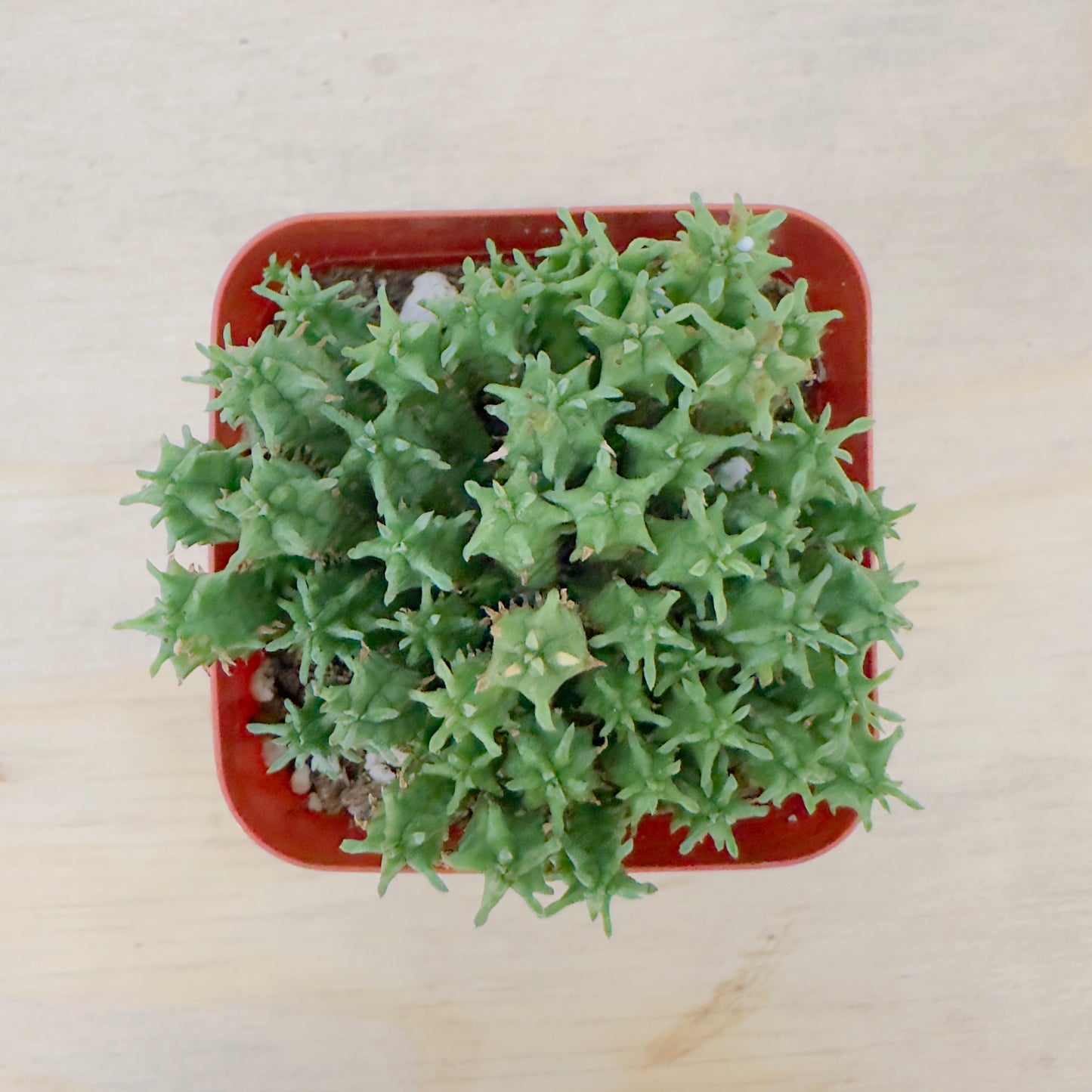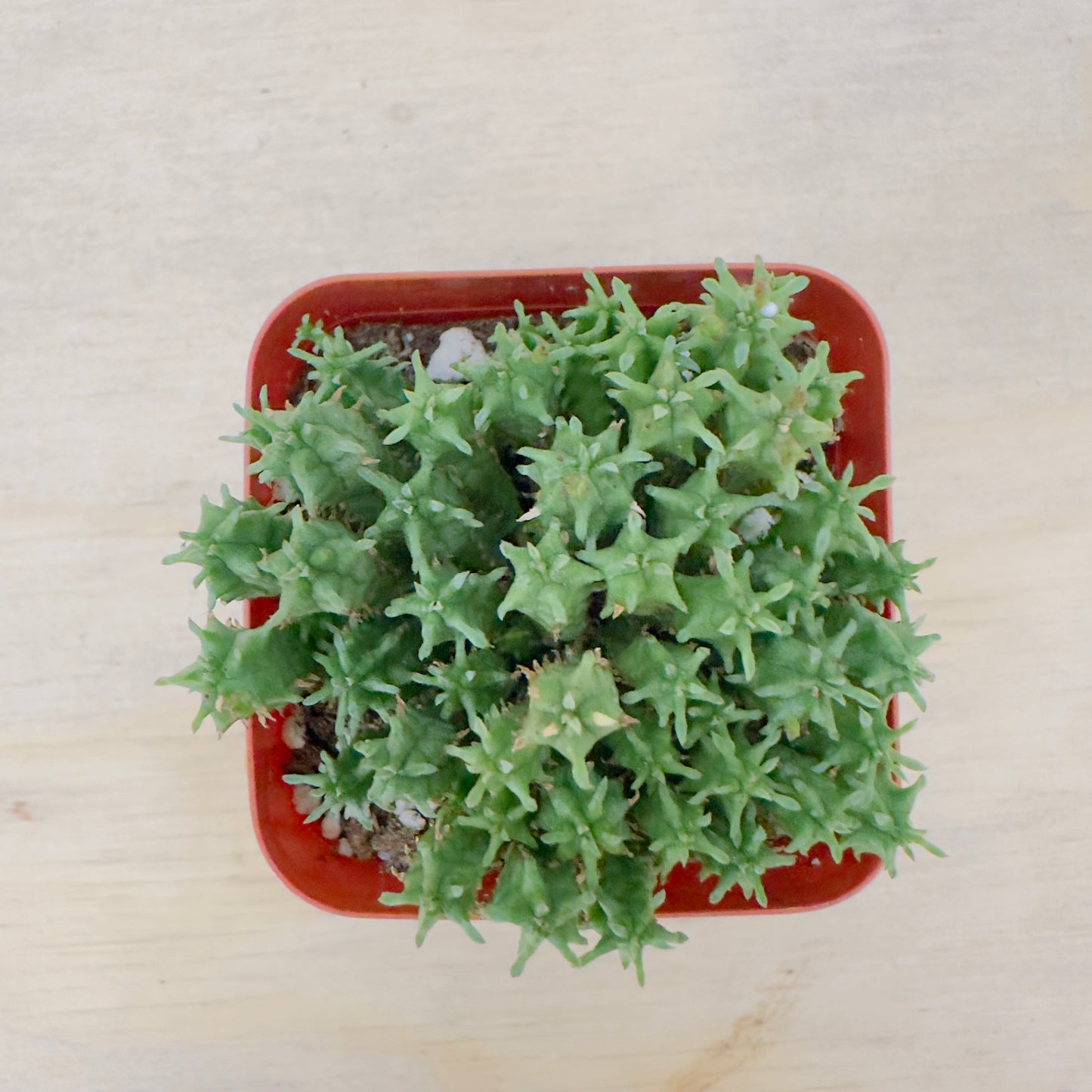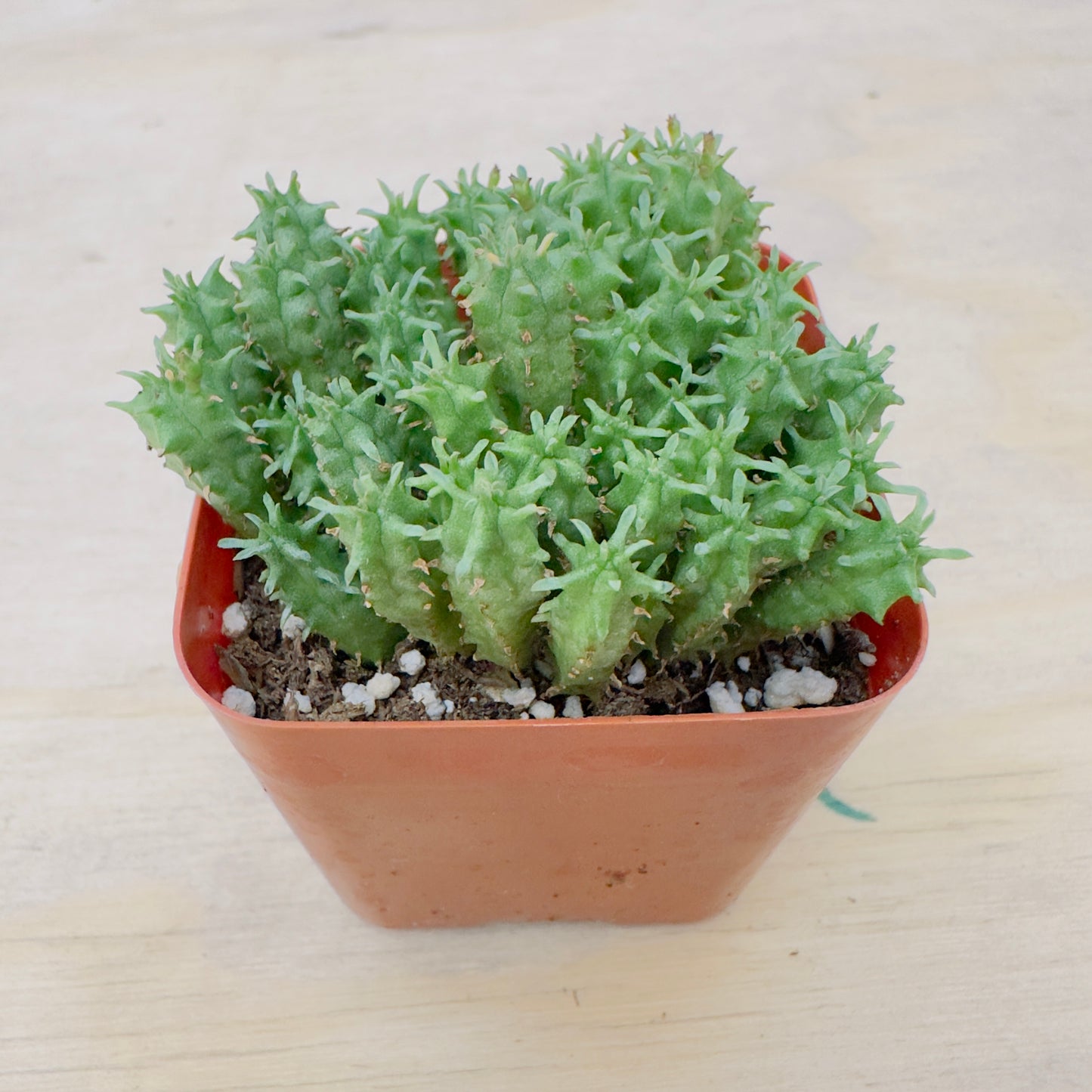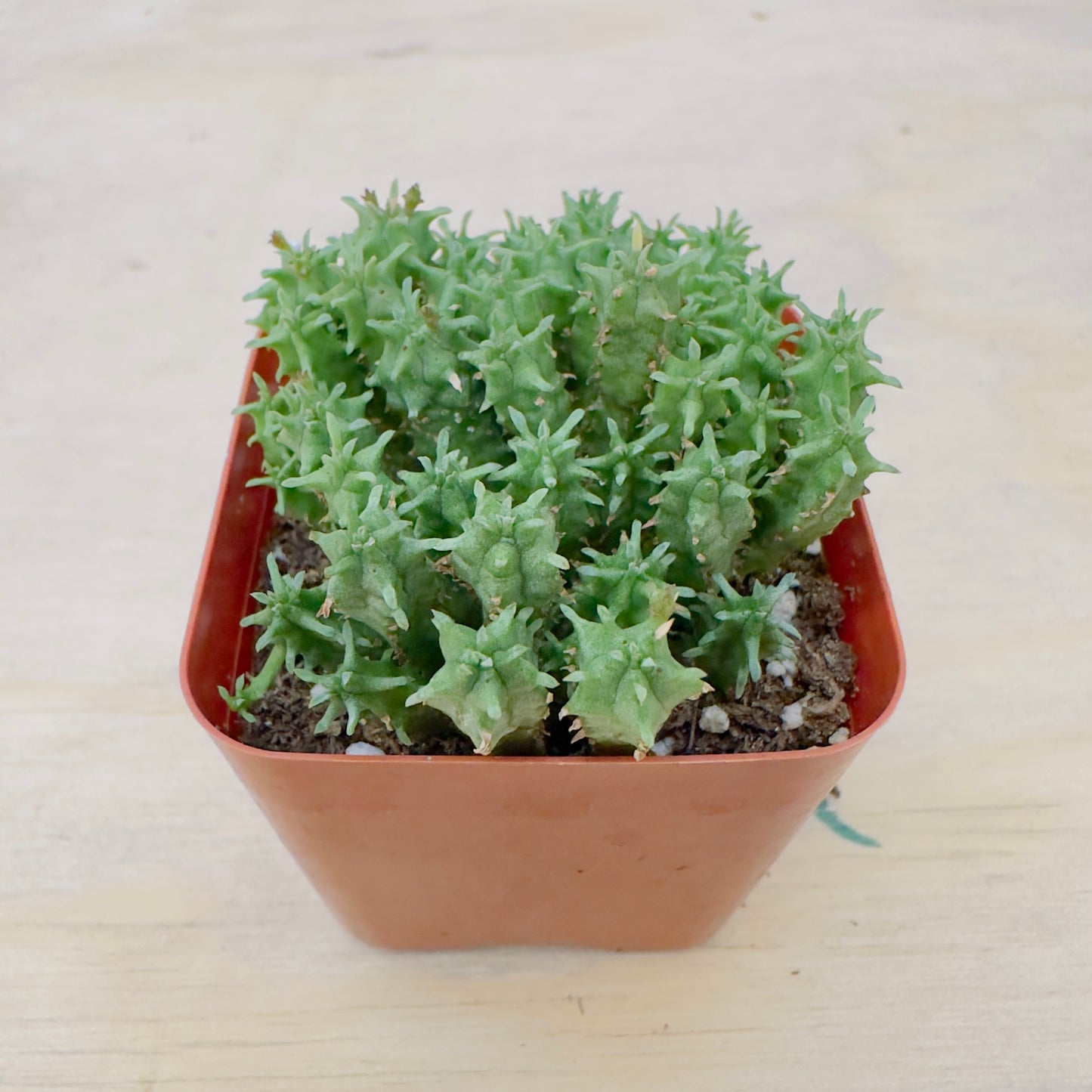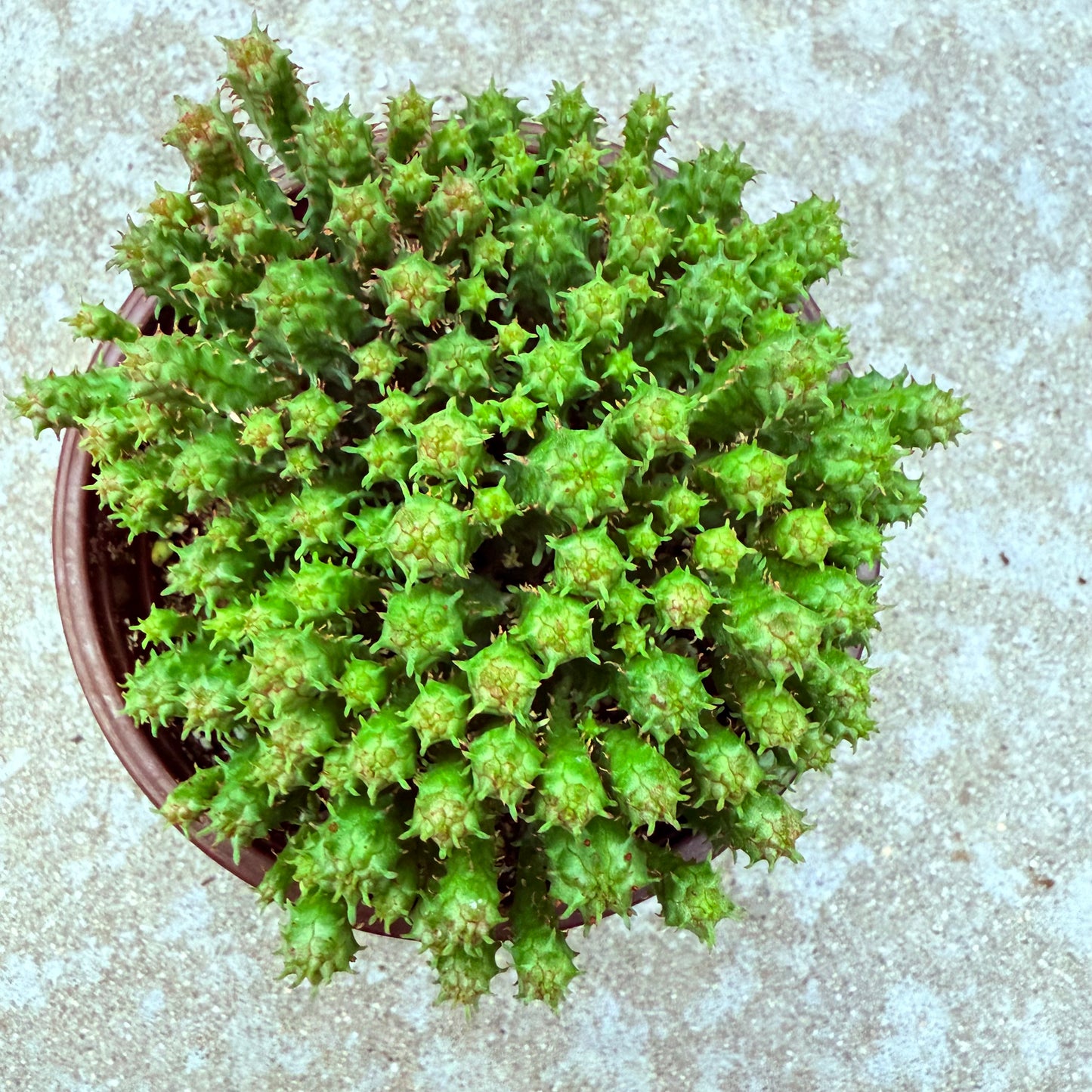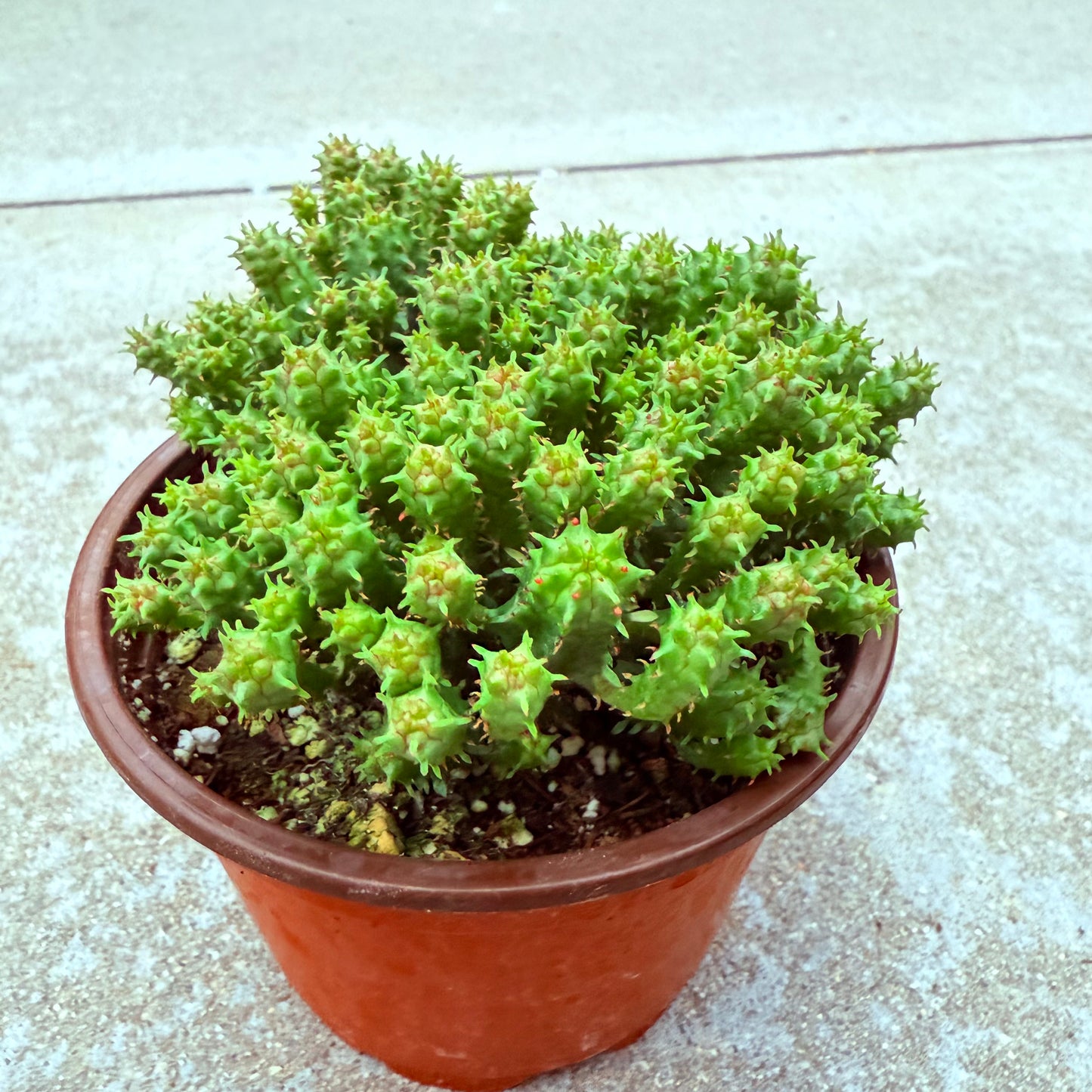Euphorbia submammillaris
Euphorbia submammillaris
In stock
Couldn't load pickup availability
📝 Description
**Morphological Characteristics**
Euphorbia submammillaris is a distinctive succulent species in the Euphorbiaceae family, native to South Africa. It is prized for its unique, spiny, segmented appearance that often leads it to be mistaken for a cactus, though it is a true euphorbia.
This species forms a dense, low-growing cluster of columnar stems that are light green to bluish-green. Each stem is thick, ribbed, and segmented by closely spaced tubercles (small projections). From these tubercles, small paired spines emerge, typically white or pale brown. Mature stems reach about 10-30 cm (4-12 inches) in height and around 2-4 cm (0.8-1.6 inches) in diameter. In the growing season, especially in spring and early summer, Euphorbia submammillaris produces tiny, yellow-green cyathia (specialized euphorbia flowers) at the stem tips, adding a delicate touch of color.
**Growth Habits**
Euphorbia submammillaris is a moderate to fast-growing succulent that forms a clumping habit over time. It spreads by producing numerous offsets at the base, eventually creating dense, sculptural mounds. Its compact, architectural structure makes it ideal for container gardens, succulent arrangements, and xeriscaping projects.
**Maintenance Points**
• Lighting: Prefers full sun to bright, indirect light. Outdoors, place it where it can receive at least 6 hours of sunlight per day. Indoors, position it near a south-facing window for best results.
• Watering: Water thoroughly during the growing season (spring and summer) but allow the soil to dry completely between waterings. Water very sparingly during the dormant period (fall and winter).
• Soil: Requires a very well-draining succulent or cactus soil mix. Incorporate pumice, coarse sand, or perlite to enhance drainage and aeration.
• Temperature: Ideal temperatures range between 18-27°C (65-80°F). It can tolerate brief, light frosts down to about -2°C (28°F) if kept dry but is best protected from freezing conditions.
• Fertilization: Apply a diluted, balanced succulent fertilizer once a month during the active growing season. Avoid fertilizing during dormancy.
• Potting: Use shallow pots with excellent drainage holes. Repot every 2-3 years or when the plant becomes overcrowded.
• Humidity: Thrives in low humidity environments. Good air circulation helps prevent fungal issues.
**Reproduction Method**
Euphorbia submammillaris can be propagated through stem cuttings and seeds.
1. **Stem Cuttings:**
• Selection: Cut a healthy stem segment with a clean, sharp knife.
• Handling Sap: Euphorbia sap is toxic and can irritate skin and eyes; always wear gloves when handling cuttings.
• Callusing: Allow the cutting to dry and callus for several days in a shaded, dry area.
• Planting: Place the callused end into a well-draining soil mix. Water lightly once roots begin to develop.
2. **Seeds:**
• Sowing: Sow seeds on the surface of a sterile, well-draining seed mix.
• Germination: Keep lightly moist and maintain temperatures between 21-27°C (70-80°F). Germination may take several weeks.
• Transplanting: Once seedlings are strong enough, move them into individual pots.
**Additional Tips**
• Safety Note: The white latex sap is toxic and can cause irritation. Keep away from pets and children and handle with care.
• Pest Control: Watch for pests such as mealybugs, aphids, and spider mites. Treat early with neem oil or insecticidal soap.
• Disease Prevention: Ensure excellent drainage and avoid overwatering to prevent root rot and fungal diseases.
• Display: Its striking, clustered form and spiny texture make it a standout specimen in succulent gardens and modern landscape designs.
Euphorbia submammillaris offers a bold, architectural presence in any collection, combining ease of care with an eye-catching, sculptural beauty.
🌿 Care Tips
Plant Care
Light
Water
Soil
Temperature
🌟 Note: It’s normal for succulents to appear slightly shriveled after shipping. They usually recover within a few days in a suitable environment.
📦 Shipping Info
Seah Shipping Policy
Effective Date: November 2025
This Shipping Policy applies to orders delivered within the continental United States (the lower 48 states). By purchasing from Seah, you agree to the terms below.
1) Shipping Cost & Free Shipping
- Automatic rate calculation: Shipping is calculated at checkout based on weight, destination ZIP and carrier rates.
- Free Standard Shipping: Orders $59+ (pre-tax, after discounts) ship free to the lower 48 states.
- Alaska, Hawaii, Puerto Rico & other territories: Not eligible for free shipping or standard flat offers at this time.
- Taxes/Duties: Applicable sales tax and any fees are shown at checkout.
2) Processing Schedule
- Business days only: We process and ship Monday–Friday. No shipping on weekends or U.S. federal holidays.
- Handling time: 1–3 business days after payment confirmation.
- Cut-off time: Orders placed before 3:00 PM (PST) are prioritized for same-day processing; others roll to the next business day.
- Changes/Cancellations: Email support@seah.co within 12 hours of purchase; after that, the order may already be in processing.
3) Transit Times
| Method | Estimated Transit | Total ETA (Handling + Transit) |
|---|---|---|
| Standard | 5–8 business days | 6–11 business days |
| Express | 3–4 business days | 4–7 business days |
ETAs are estimates. Weather, holidays, carrier delays or high-volume periods may extend delivery times.
4) Seasonal Temperature & Plant Safety
- Winter (Nov–Mar): We strongly recommend adding a heat pack at checkout to protect plants from freezing. Orders shipped without a heat pack during cold conditions are not covered for cold damage.
- Summer heat: During extreme heat waves, we may hold shipments until temperatures normalize. We’ll notify you if there’s a hold.
- Packaging: Plants are carefully packed (bare-root or potted by type/size) to minimize transit stress.
5) Carriers & Tracking
- We ship via USPS / UPS / FedEx, selected automatically for best service to your address.
- When your order ships, you’ll receive a tracking email. Tracking typically activates within 24 hours.
- If you haven’t received tracking within 3 business days, contact us at support@seah.co or +1 (626)-999-1314.
6) Address Changes & Delivery Issues
- Before shipment: Request address changes within 12 hours of ordering.
- After shipment: We can’t modify the address once dispatched. Please contact the carrier for redirection options.
- PO Boxes: Supported for USPS only; UPS/FedEx require a street address.
- Seah isn’t responsible for delays or loss due to incorrect addresses provided at checkout.
7) Service Area
We currently ship to the continental U.S. (lower 48 states). Orders to AK/HI/PR and other territories are not eligible for free shipping and may be restricted.
8) Support
- Hours: Mon–Fri, 9:00 AM – 5:00 PM (PST)
- Phone: +1 (626)-999-1314
- Email: support@seah.co
- Address: 7870 Margaux Pl, Rancho Cucamonga, CA 91739, United States
Thank you for supporting our California nursery—each plant is hand-selected and packed with care. 🌱
